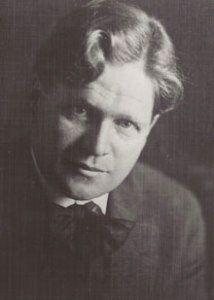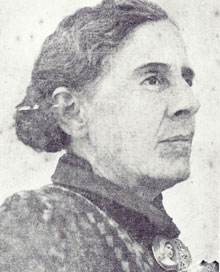
Courtesy Willoughby City Library
Marion Mahony, the second women in the USA to gain a professional degree in architecture (1894) and the first to be licensed as an architect (Illinois 1898), was greatly influenced by a group of feminists, religious reformers, artists and individuals who gathered around her mother, Clara Perkins Mahony. Marion’s achievements as an architect were modest, but her artistic skills in interpreting the creative ideas and designs of two of America’s greatest modern architects, Frank Lloyd Wright and Walter Burley Griffin, into the distinctive perspective drawings that brought the Prairie School of architecture into international prominence was fundamental to their recognition.
Griffin was inspired by ideals of equity and democracy and a passionate regard for nature. In 1900, as a recent architectural graduate Griffin, inspired by Louis Sullivan, resolved to create his own kind of modern architecture independent of past styles. He graduated in architecture in 1899 and worked in the studios of several progressive architects before going to Wright’s Oak Park studio in 1901. Following conflict with Wright, he established his own studio in 1905, Marion joined him there and they married in June 1911.
Following a visit to Australia from May 1913, Walter Griffin was appointed as Director of Design and Construction for the Federal Capital project. He returned to Chicago to wind up his affairs there, returning to Sydney with Marion and his relatives, the Lippincott’s in May 1914. They established a home and private practice in Melbourne and Walter spent six frustrating years working on the National Capital project. Marion kept their Melbourne practice going at this time and played a significant role in their major collaborative projects, such as the Capitol Theatre. The obstacles created by wartime austerity measures, bureaucrats and politicians became too great, however, and he was forced to resign from the project on 31 December 1920.
Walter had been inspired by the beauty of Sydney Harbour when he first visited in 1913 and by 1919 he had already firmed up plans to apply his landscaping and design skills to the development of model garden suburbs in this location. Backed by Melbourne businessmen, politicians and personal associates, Griffin formed the Greater Sydney Development Association (GSDA) in 1920 as his vehicle for realising his new dream. Within a few months the GSDA had purchased 263 hectares of land on three Middle Harbour peninsulas that were to become the suburbs of Castlecrag, Middle Cove and Castle Cove.
Two estates at Castlecrag were the first to be developed. In Australia, both Walter and Marion had developed a keen interest in the characteristics of their new environment, particularly the Australian bushland. They acquired a good knowledge of the nature and habits of Australian flora and their enthusiasm for indigenous trees and shrubs was far ahead of its time. By the time they moved to Castlecrag in autumn 1925, the Griffins had placed the natural Australian landscape and its preservation as a dominant theme in their ideas for the model community they wished to establish.
In Castlecrag the Griffins set out to demonstrate that architecture and landscape should be integrated so that: ‘… each individual can feel that the whole of the landscape is his. No fences, no boundaries, no red roofs to spoil the Australian landscape; these are some of the features that will distinguish Castlecrag’.
The Griffins personally undertook the design of the roads and allotments with the winding roads following the contours of the landforms. Over 6 hectares of the estate, including all the foreshore land, was dedicated to public reserves by the Griffins. Communal areas were linked together with a network of walkways to provide open spaces, retain views and achieve maximum amenity for all residents. Equally important was respect for the native Australian landscape which the Griffins had come to understand and admire.

Courtesy Walter Burley Griffin Society Inc
Marion’s colleague. Louise Lightfoot, recalls:
Certainly Marion could be called a ‘square bohemian’. She was completely unconventional yet strict. There were no arguments or shouting in her house, no lies, no unkindness, no pessimism . . . she was as volatile as Waltie was reserved. She looked after him as well as she knew how . . . I never knew them to be ill or to see a doctor. In fact sickness was almost a disgrace.1
As the decade wore on and economic conditions deteriorated there was increasing conflict between the Griffins, backed by their Sydney based shareholders and supporters, and the larger GSDA shareholder base in Melbourne. Their financial position became vulnerable and Walter turned to his former Melbourne client, Nisson Leonard-Kanevsky, for new design opportunities. Kanevsky had established the Reverberatory Engineering Company Pty Limited (RIECo) to market Australian designed and manufactured incinerators to municipal authorities. His ‘master-stroke’ was to engage Walter Burley Griffin to design outstanding buildings that addressed the political dimensions of local government decision-making through industrial buildings that were in harmony with the specific setting of each incinerator. The Willoughby Incinerator, opened in September 1934, is regarded by many as Griffin’s finest industrial building.
Responsibility for GSDA matters was increasingly left in the hands of Griffin’s architectural partner, Eric Milton Nicholls. In 1935 Griffin was invited to tender for a new University Library in the northern Indian city of Lucknow. Completing most of the design while still in Sydney, Griffin sailed for India in October 1935 intending to be away only three months. Once in India, he soon found a new spiritual home and commenced a new phase of outstanding architectural works in completely new and creative designs.
Marion Mahony joined Walter at Lucknow in 1936 to help with the university library and other projects, which included residences, university buildings, a building for the Pioneer Press and the entire United Provinces Industrial & Agricultural Exhibition. Once more their partnership flourished in creative designs based on vastly different cultural traditions, but this was cut short when Walter died suddenly in 1937. Marion returned to Castlecrag, and then moved back to the United States in 1939.
Further reading
Walker, Meredith, Kabos, Adrienne and Weirick, James, Building for nature: Walter Burley Griffin and Castlecrag. Sydney, Walter Burley Griffin Society Incorporated, 1994
Watson, Anne (ed), Beyond architecture: Marion Mahony and Walter Burley Griffin in America, Australia and India. Sydney, Powerhouse Publishing, 1998
David van Zanten (ed), Marion Mahony Reconsidered, University of Chicago Press, 2011.
Walter Burley Griffin Society website: http://www.griffinsociety.org/index.html
1Leslie, Esther, The Suburb of Castlecrag: A community history, Chatswood, Willoughby Municipal Council, 1988, p79
